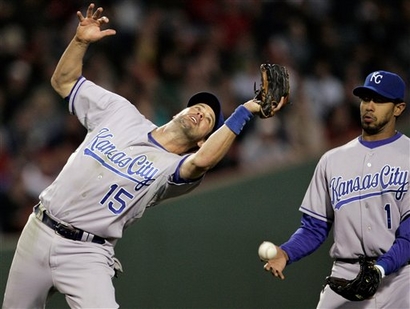Todd Jones announced on Wednesday that he will be retiring at the end of the year. Even considering that I had assumed he was already retired, this kind of surprised me, since it seemed to me that Jones is exactly the sort of pitcher who would keep pitching forever, since he might be useful as a mop-up man throwing junk even after his fastball had deserted him. Jones always relied more on his sinker anyway.
He doesn't need the gig, of course, having drawn over $37 million in salary in his 16-year career. He also writes for the Sporting News, and will apparently continue to do so, though as Rob Neyer points out, I'm not really sure why anyone would care, once he's no longer playing.
Jones was drafted in the first round (27th overall) by the Houston Astros in 1989. That was a seriously talented first round draft, with eleven players who spent at least 8 seasons in the majors. Among them, Frank Thomas is easily the best, but Mo Vaughn won an MVP award, Charles Johnson was (for a while) an effective hitter with the best catcher's arm in the league, and Cal Eldred and Ben MacDonald were both dozen-game winners on several occasions. Also out of the later rounds of that draft (i.e. after Jones): Phil Nevin, Shane Reynolds, Denny Neagle, Ryan Klesko, J.T. Snow, and arguably the best player in LAnahfornia history, Tim Salmon. Oh, and futue Hall of Famers Jeff Bagwell, Jim Thome, Jeff Kent and Trevor Hoffman, though he was drafted as a shortstop. Talk about a deep draft.
So anyway: Jones. He wasn't as good as any of those guys. For one thing, he was a relief pitcher. He made 982 appearances in his MLB career, but only one start. He was a starter in the minors, like almost everyone who gets drafted to pitch, but not a very good one, and therefore not for long. His career record at all levels in the minors was 27-24, 4.15 ERA, which makes him that rarest of commodities, the pitcher with a lower ERA in the majors (3.97) than in the minors. After three years of starting at Single-and Double-A, Jones had a career record of 23-22 and a 4.13 ERA, so they turned him into a relief pitcher while promoting him to AAA, and he...
...was mediocre.
4-2, 4.44, 31 walks in 49 innings. Surprisingly, that was good enough for the 1993 Astros to call him up, and he was a lot better than you'd think, though I imagine that a lot of the apparent improvement in his numbers had to do with moving from the hitter-friendly PCL to the pitcher friendly Astrodome. Let me check...
...yep: 1.42 ERA at home, 4.91 on the road.
But he stuck around for 15 more seasons, and didn't always have the inward-blowing air conditioning in the AstroDome to thank for his success. In 1996 he was swapped to Detroit in a 9-player trade, which wasn't all that unusual, since the father and son who served as General Managers of each team used to make a trade like that about once a week, or so it seemed. In Detroit he became the full-time closer and racked up about 30 saves a season for four and a half years. He led the AL in Saves and therefore won the Rolaids Relief Man of the Year award in Y2K, and was even an All-Star in 2000, finishing (brace yourself...) 5th in the AL Cy Young voting that year.
Of course, that was the second straight year that Pedro Martinez won the award unanimously, so 5th place was a very distant 5th. The 3 points he amassed mean that Detroit's two beat writers probably put him on their ballots last and second to last, respectively. Still, 5th in the Cy Young voting! Woo hoo! Oh, wait, that's the Indians.
Anyway, Jones was traded to Minnesota in 2001 for the stretch drive and became a setup man, a role in which he served for five different teams over the next three and a half years. In Florida in 2005, he again became a closer, saving 40 games with a 2.10 ERA for the Marlins, which could be argued to be his best season, though I would suggest that 1995 may deserve that honor. Yes, a slightly higher ERA, but he also pitched almost 100 innings of effective relief, and this in a strike-shortened year.
With the closer tag firmly affixed to his back, Jones returned to the Tigers and racked up 75 saves over the 2006-07 seasons, plus another 18 this year before giving way to injuries. His ERA this year is an unimpressive 4.97, but in truth the 3.94 he put up in 2006 and the 4.26 he had last year weren't great either. The standard for a good relief pitcher is to post an ERA at least a run below the league average, and Jones was just a hair better than average each of those two years, as he frequently was.
1997: "He’s going to scuffle for a while."
1999: "...he doesn’t merit his role [as closer] - or the salary that
comes with it."
2000: "...he’s really no better than Turk Wendell or Tim Crabtree, and he’s
not likely to get any better."
2001: "...Jones wasn’t appreciably better than he'd been in previous
seasons."
2002: "his peripheral numbers are getting scary; declining strikeout rates
and increasing hit totals are not good trends."
2005: "Another element in the Phillies' master plan to counteract the
injuries to their starting pitchers by acquiring as many washed-up middle
relievers as possible."
2006: "Given his age, he`s a very shaky bet to repeat."
2007: "...second-worst pitcher ever to reach that [300 save] mark...he
skirts the edge and could implode any minute now."



















